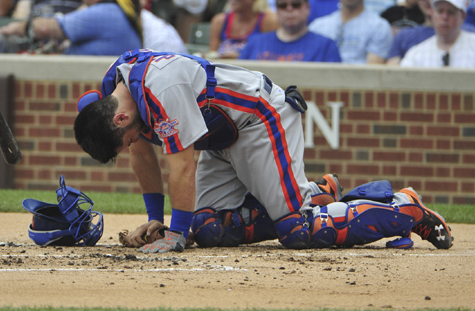
For years now we have been told that Travis d’Arnaud is the current and future franchise catcher for the New York Mets. His growth has been long and expected since he was drafted 37th overall by the Phillies in 2007. The very next season, he was ranked as that organization’s seventh-best prospect. The next year, he moved up to fourth. After d’Arnaud was dealt to Toronto, he was their top overall prospect in back-to-back seasons in 2011 and 2012. Upon becoming a Met, d’Arnaud’s star hardly faded; he was the second best prospect for the Mets in 2013.
D’Arnaud could always rake in the minor leagues. He has a career minor-league slash line of .290/.352/.483. That was his bread and butter. Even as his defensive skills left something to be desired and eventually became a nuisance, everyone agreed he could hit. Offensive minded catchers with d’Arnaud’s upside and potential are so rare that it was worth putting up with everything else that fell short.
Nearly through the 2016 MLB season, it is now worth asking the reverse question in regards to his future with the Mets. Is he actually a good enough hitter to warrant putting up with everything else that falls short?
D’Arnaud is a career .245 hitter in the Majors. His walk rate has always been incredibly low for a player with as little power as d’Arnaud possesses. Essentially, his value is created almost entirely from the position he plays, yet he doesn’t play that position well. He has been a minus defender every year of his Major League career. He has been particularly terrible at throwing out base stealers as well, especially in 2016. d’Arnaud has thrown out 18 percent of attempted runners. Compare that to the league average of 29 percent or his teammate Rene Rivera at 32 percent.

There is some indication that d’Arnaud is a good pitch framer in that he is able to grab extra strikes for his pitchers with balls that are out of the zone. The numbers bear this out, but without umpire data or information on the specific starters, it is harder to know how much credit to give specifically to d’Arnaud.
Even if you grant him the ability to be a consistently above-average framer, d’Arnaud still ends up as nothing more than a replacement-level player. This season he has actually been worse than that (-0.5 WAR) for the Mets. Rivera (.03 WAR), the Mets’ backup catcher, has been the more valuable player. Considering d’Arnaud isn’t hitting, this isn’t that odd.
There are also all the injury concerns that go along with this former top prospect. He finds his way to the disabled list every season. Most years, it happens more than once. Travis has played 70 games in a year just once, and that season, 2014, he only managed to see action in 108 games. That is his career-high mark: 108 games, 385 at-bats. This is not a player that can be counted on for even weekly timeshare duty. New York needs two other catchers splitting duty to overcome d’Arnaud’s absences.
It may seem harsh, but a lot has ridden on d’Arnaud’s ascension through the organization. He was supposed to be a lynchpin of the offense at one of the premiere defensive positions on the diamond. Instead, he has turned into a league-average bat on his good days and well below average overall. He is still just 27 years old, so if he ever has a fully healthy season in him, everything may end up coming together. But at this juncture, the bat isn’t where it needs to be, and neither is the rest of his game. It is unfortunate, but Travis d’Arnaud is not the Mets’ answer at catcher. They need to look elsewhere.
m














